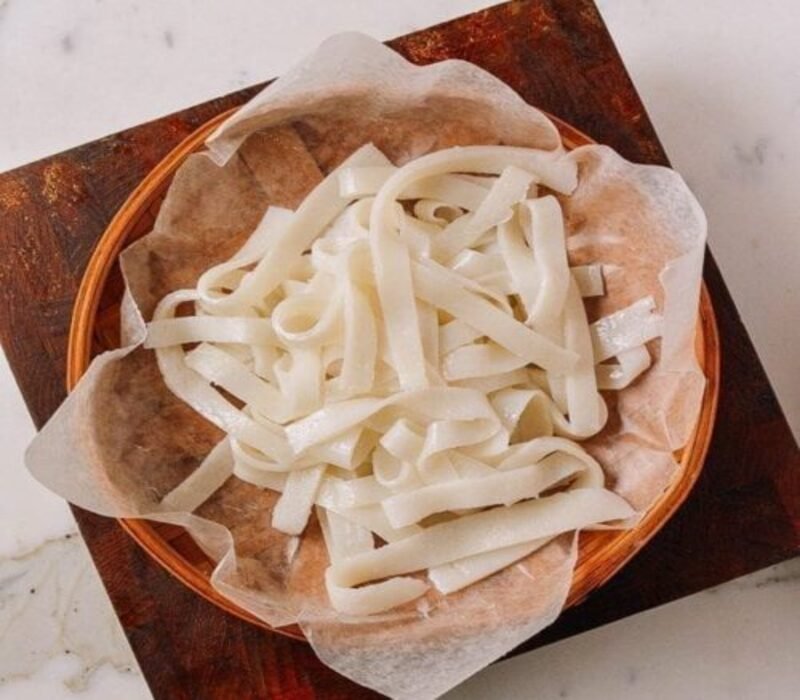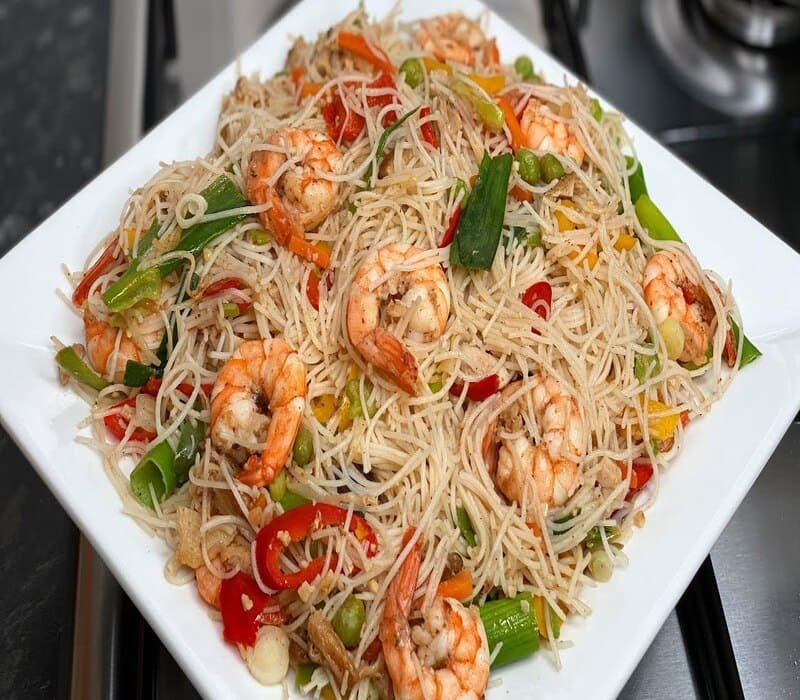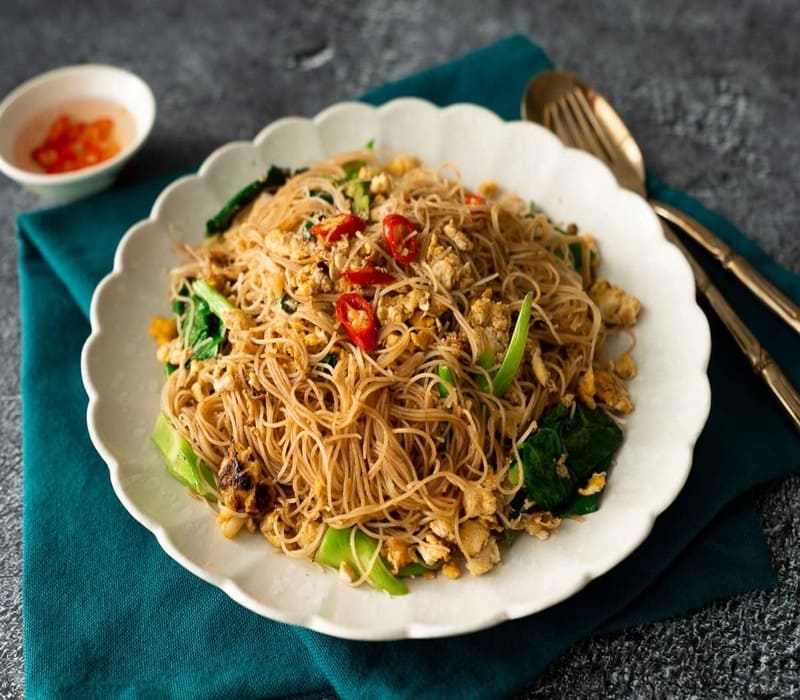Noodles are a wholesome dish that complies with international food safety regulations. Consumer demand for high-quality noodle products rises along with the growth of the Asia-Pacific economy. Rice noodles are the most consumed form of rice product that is most popular in Asia. Noodles can either be served as soup noodles by boiling in broth or by frying and mixed with meats and veggies.
Page Contents
Rice Noodles
Rice is used to make rice noodles. It is made from the seed of the grass Oryza sativa, often known as Asian rice, or, less frequently, Oryza Glaberrima (African rice). Such noodles in Raw form are brittle. They become transparent and chewy after cooking. They cook quickly and could become pulpy if overcooked.
Rice flour and water are the main materials used to make rice noodles. To boost the gelatinous and chewy texture of the noodles or to increase their transparency, substances like tapioca or cornstarch are occasionally added. Most cuisines in East and Southeast Asia use these noodles.
They come in a variety of sizes, thicknesses, and textures and can be purchased fresh, frozen, or dried. Additionally, freshly made noodles have a short shelf life, sometimes only a few days.

Origin of Rice Noodles
According to history, invaders from the north of China were more accustomed to eating wheat noodles than cooked rice when they arrived in the south of the country. The rice noodle was created when Northern cooks tried creating noodles from rice flour because rice was a plentiful crop in the South.
Quality Characteristics of Rice Noodles
The qualities of cooked and uncooked rice noodles are taken into consideration while determining the qualitative attributes of noodles. Consumers consider cooking qualities such as high transparency, glossiness, and lack of discoloration when choosing noodles to buy.
The characteristics of premium grade and more expensive noodles are often believed to be fine, straight strands, translucency, whiteness, and the lack of broken strands. After cooking, the noodles must still be firm, chewy, and non-sticky. Rice noodles of high grade must cook fast and with low cooking loss.
The main criterion for evaluating rice noodles is their noodle attributes, which include uniformity of size, shape, texture, and color as well as their nutritional, textural, and cooking qualities.
How to Prepare Rice Noodles?
Aging
Before making noodles, raw (unmilled) rice is matured for up to 9 months by storing it in appropriate conditions to allow for physiochemical changes to occur naturally. The unmilled rice is aged in this way to produce noodles with a firmer, more palatable texture as well as cooked rice that is fluffier and stiffer.
Fermentation
The rice is washed after it has been well-aged and then steeped in water for several hours to several days, where its fermentation occurs due to the presence of naturally occurring bacteria.
Wet Milling
Finally, the rice is ground into wet-milled flour by passing it through a mill while being regularly moistened with water.
Pre Gelatinization
Rice flour must go through a procedure called pre-gelatinization to help it form a cohesive dough because it lacks gluten and has poor binding qualities. Pre-gelatinization is the process of drawing out the natural starch in rice to assist the dough to hold together when it is formed into balls. Boiling water or steam is added to rice flour. At this stage, corn flour, potato starch, or tapioca starch may also be added for enhancing the appearance and texture of noodles.
Shaping
After the dough has been created, it is molded and shaped into noodles. Before heating, the dough is stretched into sheets and then cut into long strips. The dough created from rice flour is extruded through a mold and into boiling water to create other types of noodles, such as thin vermicelli or slim laksa noodles, which are cooked for 1-2 minutes. These noodles must be promptly chilled in a cold water bath at a temperature of 0 to 10 C after cooking.
Drying and Packaging
The noodles are then washed to get rid of any sticky starch, and after that, they are either packaged as fresh rice noodles or further dehydrated.
Nutritional Info
| Calories | 588 |
| Carbs | 23g |
| Fats | 63g |
| Proteins | 33g |
Ingredients
The ingredients for preparing these noodles are as under,
- 1/4 pound shrimp
- 4 tablespoons plus 2 teaspoons canola or vegetable oil, divided
- 2 1/2 teaspoons Asian fish sauce, divided
- 1 bundle of dried rice stick noodles
- 2 medium cloves garlic, minced
- 1 tablespoon curry powder
- 1 teaspoon soy sauce
- 1 teaspoon Shaoxing wine
- 1/4 teaspoon ground white pepper
- 1/4 teaspoon sugar
- 2 large eggs
- 1/4 pound Chinese roast pork, cut into thin strips
- 1/4 medium onion, very thinly sliced
- 1/2 medium red bell pepper, stemmed, seeded, and julienned
- 12 snow peas
- 1/2 medium carrot
- Kosher salt
- 2 scallions
- 2 teaspoons toasted sesame oil
Steps For Preparation
- Put the shrimp in a small bowl after patting them dry with paper towels. Add 1 teaspoon of canola oil and 1/2 teaspoon of fish sauce. Mix well and set aside in the refrigerator
- Now place rice noodles in a large bowl and cover with boiling water. Let stand until pliable, about 5 minutes. Noodles should be drained in a colander before being transferred to a wire rack-lined baking sheet with a rim. Noodles should be evenly spread before being sliced in two using scissors
- Place garlic in a small bowl and add 2 teaspoons of curry powder along with soy sauce, Shaoxing wine, white pepper, sugar, and the remaining 2 teaspoons of fish sauce. Mix well, thinning with 2 teaspoons water, then set sauce aside
- Heat 1 teaspoon of canola oil in a wok or nonstick skillet over high heat, tilting to swirl oil, until smoking.
- Add eggs and let cook undisturbed for about 10 seconds, then gently move the eggs back and forth with a spatula until they start to firm up. Break eggs into small pieces, then set aside in a large bowl
Mixing
- Clean up the cooking pan. Again reheat the pan, add 2 tablespoons oil, and heat until smoking. Add shrimp and stir-fry for 30 seconds. Add roast pork and onion and continue to stir-fry for another 30 seconds. Add red bell pepper and snow peas and stir for another 30 seconds, then add carrots
- Add remaining 1 teaspoon curry powder, season with salt, and cook, tossing, until curry is evenly distributed. Scrape wok contents into a bowl with eggs
- Clean up the cooking pan again. Heat the remaining 2 tablespoons of canola oil over high heat until smoking. Add rice-stick noodles and stir-fry for 30 seconds. Stir in the sauce until the curry powder is evenly distributed, adding water 1 or 2 teaspoons at a time as needed to help distribute the sauce
- Return egg, shrimp, roast pork, and vegetables to wok and stir-fry until everything is evenly combined, about 30 seconds. Season with salt and remove from heat
- Add scallions, drizzle with sesame oil, mix well, and transfer to a large serving bowl. Enjoy immediately

Health Benefits
Although they are not considered a food that is good for your health, rice noodles are viewed as an alternative to normal pasta noodles. Even so, rice noodles are a fantastic gluten-free spaghetti substitute and can be a healthy complement to a diet that is well-balanced.
Increase Energy Levels
These noodles are useful for boosting and maintaining energy levels because they are primarily composed of carbohydrate calories.
Gluten-free
A gluten-free diet is especially advantageous for those who eat rice noodles. Those rice noodles that are gluten-free should be consumed by people with celiac disease and non-celiac gluten sensitivity. Additionally, rice noodles are suitable for low-fat, low-calorie, vegan, and vegetarian diets.
Conclusion
Rice is used to make simple noodles. Patients with celiac disease and gluten intolerance benefit greatly from it. It is also a high potassium, low sodium, low fat, and low carbohydrate snack.
In Asia, people consume it as a staple dish, and it has its origins in China. It can replace traditional noodles in a variety of recipes because it is easily digested.
Rice-based goods are healthy for the stomach because they are low in fat and fiber. Additionally, due to its high glycemic index, sugars are broken down more quickly by the body and released into the bloodstream more quickly. As a result, sugar will be simple to digest and simply broken down by the body.
According to a USA research study, 19 mg of sodium is present in 100 grams of rice noodles. Our bodies require very little salt. High salt intake can lead to high blood pressure, cardiac problems, and strokes. Because it raises blood pressure, high sodium consumption is also bad for the kidneys.
As compared to egg noodles, rice noodles are fewer in calories, fat, and protein. They contain more carbs as well. About 193 calories, 0.4 grams of fat, 43.8 grams of carbohydrates, 1.8 grams of fiber, and 1.6 grams of protein are present in one cup of cooked rice noodles made from white rice.

